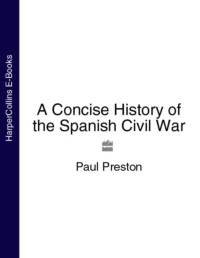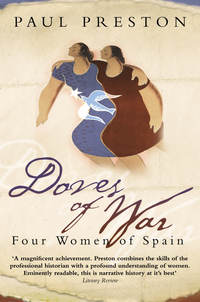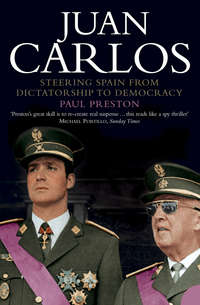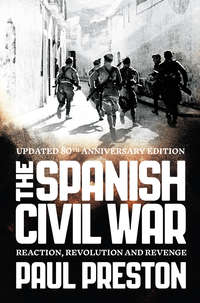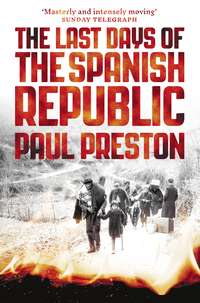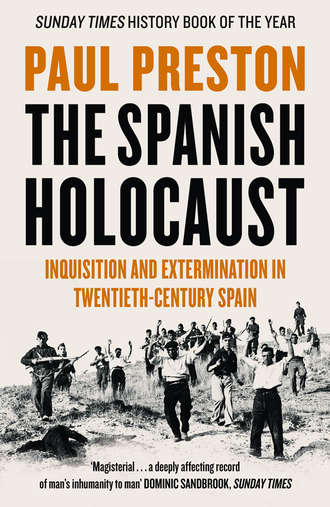
Полная версия
The Spanish Holocaust: Inquisition and Extermination in Twentieth-Century Spain

The Spanish Holocaust
Inquisition and Extermination in Twentieth-Century Spain
Paul Preston

Copyright
HarperPress
An imprint of HarperCollinsPublishers
1 London Bridge Street
London SE1 9GF
www.harpercollins.co.uk
Published in Great Britain by HarperPress in 2012
Copyright © Paul Preston 2012
Paul Preston asserts the moral right to be identified as the author of this work
A catalogue record for this book is available from the British Library
THE SPANISH HOLOCAUST. Copyright © Paul Preston 2012. All rights reserved under International and Pan-American Copyright Conventions. By payment of the required fees, you have been granted the nonexclusive, nontransferable right to access and read the text of this e-book on-screen. No part of this text may be reproduced, transmitted, downloaded, decompiled, reverse-engineered, or stored in or introduced into any information storage and retrieval system, in any form or by any means, whether electronic or mechanical, now known or hereinafter invented, without the express written permission of HarperCollins e-books.
Source ISBN: 9780002556347
Ebook Edition © JANUARY 2013 ISBN: 9780007467228
Version: 2016-07-04
Dedication
For Gabrielle
CONTENTS
Cover
Title Page
Dedication
List of Illustrations
Prologue
PART 1: THE ORIGINS OF HATRED AND VIOLENCE
1 Social War Begins, 1931–1933
2 Theorists of Extermination
3 The Right Goes on the Offensive, 1933–1934
4 The Coming of War, 1934–1936
PART 2: INSTITUTIONALIZED VIOLENCE IN THE REBEL ZONE
5 Queipo’s Terror: The Purging of the South
6 Mola’s Terror: The Purging of Navarre, Galicia, Castile and León
PART 3: THE CONSEQUENCE OF THE COUP: SPONTANEOUS VIOLENCE IN THE REPUBLICAN ZONE
7 Far from the Front: Repression behind the Republican Lines
8 Revolutionary Terror in Madrid
PART 4: MADRID BESIEGED: THE THREAT AND THE RESPONSE
9 The Column of Death’s March on Madrid
10 A Terrified City Responds: The Massacres of Paracuellos
PART 5: TWO CONCEPTS OF WAR
11 Defending the Republic from the Enemy Within
12 Franco’s Slow War of Annihilation
PART 6: FRANCO’S INVESTMENT IN TERROR
13 No Reconciliation: Trials, Executions, Prisons
Epilogue: The Reverberations
Acknowledgements
Photographic Insert
Glossary
Notes
Appendix
Searchable Terms
Other Books by Paul Preston
Copyright
About the Publisher
LIST OF ILLUSTRATIONS
Franco in Seville with the brutal leader of the ‘Column of Death’, Colonel Juan Yagüe. (© ICAS-SAHP, Fototeca Municipal de Sevilla, Fondo Serrano)
Yagüe’s artillery chief, Luis Alarcón de la Lastra. (EFE/jt)
General Gonzalo Queipo de Llano. (EFE/Jalon Angel)
General Emilio Mola. (EFE/Delespro/jt)
Gonzalo de Aguilera. (Courtesy of Marianela de la Trinidad de Aguilera y Lodeiro, Condesa de Alba de Yeltes)
Virgilio Leret with his wife, the feminist, Carlota O’Neill. (Courtesy of Carlota Leret-O’Neill)
Amparo Barayón. (Courtesy of Ramon Sender Barayón)
A Coruña, Anniversary of the foundation of the Second Republic, 14 April 1936. (Fondo Suárez Ferrín, Proxecto “Nomes e Voces”, Santiago de Compostela)
José González Barrero, Mayor of Zafra. (Courtesy of González Barrero family)
Modesto José Lorenzana Macarro, Mayor of Fuente de Cantos. (Courtesy of Cayetano Ibarra)
Ricardo Zabalza, secretary general of the FNTT and Civil Governor of Valencia during the war, with his wife Obdulia Bermejo. (Courtesy of Abel Zabalza and Emilio Majuelo)
Mourning women after Castejón’s purge of the Triana district of Seville, 21 July 1936. (© ICAS-SAHP, Fototeca Municipal de Sevilla, Fondo Serrano)
Queipo de Llano (foreground) inspects the 5º Bandera of the Legion in Seville on 2 August 1936. (© ICAS-SAHP, Fototeca Municipal de Sevilla, Fondo Serrano)
Rafael de Medina Villalonga, in white, leads the column that has captured the town of Tocina, 4 August 1936. (© ICAS-SAHP, Fototeca Municipal de Sevilla, Fondo Serrano)
Trucks taking miners captured in the ambush at La Pañoleta for execution. (© ICAS-SAHP, Fototeca Municipal de Sevilla, Fondo Serrano)
Utrera, 26 July 1936. Townsfolk taken prisoner by the column of the Legion which captured the town. (© ICAS-SAHP, Fototeca Municipal de Sevilla, Fondo Serrano)
Lorca’s gravediggers. (Courtesy of Víctor Fernández and Colección Enrique Sabater)
Regulares examine their plunder. (© ICAS-SAHP, Fototeca Municipal de Sevilla, Fondo Serrano)
After a village falls, the column moves on with stolen sewing machines, household goods and animals. (© ICAS-SAHP, Fototeca Municipal de Sevilla, Fondo Serrano)
A firing squad prepares to execute townspeople in Llerena. (Archivo Histórico Municipal de Llerena, Fondo Pacheco Pereira, legajo 1.)
Calle Carnicerías (Butchery Street) in Talavera de la Reina. (© ICAS-SAHP, Fototeca Municipal de Sevilla, Fondo Serrano)
Mass grave near Toledo. (© ICAS-SAHP, Fototeca Municipal de Sevilla, Fondo Serrano)
Pascual Fresquet (centre left) with his ‘death brigade’ in Caspe. (España. Ministerio de Cultura. Centro Documental de la Memoria Histórica. FC-CAUSA_GENERAL, 1426, EXP.45, IMAGEN128)
The seizure of the Iglesia del Carmen in Madrid by militiamen. (España. Ministerio de Cultura. Centro Documental de la Memoria Histórica. FC-Causa_General, 1907, 1, p.81)
Arms and uniforms of the Falange found by militiamen in the offices of the monarchist newspaper ABC. (España. Ministerio de Cultura. Centro Documental de la Memoria Histórica. FC-Causa_General, 1814, 1, IMAGEN6)
Aurelio Fernández. (International Institute of Social History, Amsterdam, IISG-CNT)
Juan García Oliver. (International Institute of Social History, Amsterdam, IISG-CNT)
Ángel Pedrero García. (España. Ministerio de Cultura. Centro Documental de la Memoria Histórica. FC-CAUSA_GENERAL, 1547, EXP.9, IMAGEN45)
The Brigada García Atadell outside their Madrid headquarters, the Rincón Palace. (EFE/Díaz Casariego/jgb)
Santiago Carrillo. (EFE/jgb)
Melchor Rodríguez. (EFE/Vidal/jgb)
The wounded Pablo Yagüe receives visitors. (EFE/Vidal/jgb)
The cameraman Roman Karmen and the Pravda correspondent Mikhail Koltsov. (Courtesy of Victor Alexandrovich Frandkin, Koltsov family)
Andreu Nin and Vladimir Antonov-Ovseenko. (L’Arxiu Fotogràfic de Barcelona)
Josif Grigulevich, the Brigadas Especiales, Roman Karmen, then two of the NKVD staff, Lev Vasilevsky and then his boss, Grigory Sergeievich Syroyezhkin. Madrid October 1936. (Cañada Blanch Collection)
Vittorio Vidali. (Imperial War Museum)
Refugees flee from Queipo’s repression in Málaga towards Almería. (Photograph by Hazen Sise, reproduced courtesy of Jesús Majada and El Centro Andaluz de la Fotografía)
Exhaustion overcomes the refugees from Málaga on the road to Almería. (Photograph by Hazen Sise, reproduced courtesy of Jesús Majada and El Centro Andaluz de la Fotografía)
The Regulares enter northern Catalonia January 1939. (España. Ministerio de Cultura. Centro Documental de la Memoria Histórica. FOTOGRAFIAS-DESCHAMPS, FOTO.7)
Republican prisoners packed into the fortress of Montjuich in Barcelona, February 1939. (España. Ministerio de Cultura. Centro Documental de la Memoria Histórica. FOTOGRAFIAS-DESCHAMPS, FOTO.764)
No military threat from those making the long trek to the French border. (Photos 12/Alamy)
A crowd of Spanish women and children refugees cross the border into France at Le Perthus. (Hulton-Deutsch Collection/CORBIS)
Recently arrived at Argelès, women await classification. (Roger-Viollet/Rex Features)
The male refugees are detained at Argelès – the only facility being barbed wire. (Hulton-Deutsch Collection/CORBIS)
Prisoners carry rocks up the staircase at the Mauthausen-Gusen death camp. (akg-images/ullstein bild)
Franco welcomes Himmler to Madrid. (EFE/Hermes Pato/jgb)
Antonio Vallejo-Nájera. (EFE/jgb)
Himmler visits the psycho-technic checa of Alfonso Laurencic in Barcelona. (L’Arxiu Fotogràfic de Barcelona)
Drawings made by Simon Manfield during the excavation at Valdedios, Asturias, summer 2003. (© Simon Manfield. Part of the Memoria Histórica series, simonmanfield@hotmail.com)
PROLOGUE
Behind the lines during the Spanish Civil War, nearly 200,000 men and women were murdered extra-judicially or executed after flimsy legal process. They were killed as a result of the military coup of 17–18 July 1936 against the Second Republic. For the same reason, perhaps as many as 200,000 men died at the battle fronts. Unknown numbers of men, women and children were killed in bombing attacks and in the exoduses that followed the occupation of territory by Franco’s military forces. In all of Spain after the final victory of the rebels at the end of March 1939, approximately 20,000 Republicans were executed. Many more died of disease and malnutrition in overcrowded, unhygienic prisons and concentration camps. Others died in the slave-labour conditions of work battalions. More than half a million refugees were forced into exile and many were to die of disease in French concentration camps. Several thousand were worked to death in Nazi camps. The purpose of this book is to show as far as possible what happened to civilians and why. All of what did happen constitutes what I believe can legitimately be called the Spanish holocaust.
I thought long and hard about using the word ‘holocaust’ in the title of this book. I feel intense sorrow and outrage about the Nazis’ deliberate attempt to annihilate European Jewry. I also feel intense sorrow and outrage about the lesser, but none the less massive, suffering undergone by the Spanish people during the Civil War of 1936–9 and for several years thereafter. I could find no word that more accurately encapsulates the Spanish experience than ‘holocaust’. Moreover, in choosing it, I was influenced by the fact that those who justified the slaughter of innocent Spaniards used an anti-Semitic rhetoric and frequently claimed that they had to be exterminated because they were the instruments of a ‘Jewish–Bolshevik–Masonic’ conspiracy. Nevertheless, my use of the word ‘holocaust’ is not intended to equate what happened within Spain with what happened throughout the rest of continental Europe under German occupation but rather to suggest that it be examined in a broadly comparative context. It is hoped thereby to suggest parallels and resonances that will lead to a better understanding of what happened in Spain during the Civil War and after.
To this day, General Franco and his regime enjoy a relatively good press. This derives from a series of persistent myths about the benefits of his rule. Along with the carefully constructed idea that he masterminded Spain’s economic ‘miracle’ in the 1960s and heroically kept his country out of the Second World War, there are numerous falsifications about the origins of his regime. These derive from the initial lie that the Spanish Civil War was a necessary war fought to save the country from Communist take-over. The success of this fabrication influenced much writing on the Spanish Civil War to depict it as a conflict between two more or less equal sides. The issue of innocent civilian casualties is subsumed into that concept and thereby ‘normalized’. Moreover, anti-communism, a reluctance to believe that officers and gentlemen could be involved in the deliberate mass slaughter of civilians and distaste for anti-clerical violence go some way to explaining a major lacuna in the historiography of the war.
The extent to which the rebels’ war effort was built on a prior plan of systematic mass murder and their subsequent regime on state terror is given relatively little weight in the literature on the Spanish conflict and its aftermath. The same may be said of the fact that a chain reaction which fuelled retaliatory mass assassinations within the loyalist zone was set off once the exterminatory plans of the military rebels began to be implemented from the night of 17 July 1936. The collective violence in both rearguards unleashed by brutal perpetrators against undeserving victims justifies the use of the word ‘holocaust’ in this context not just because of its extent but also because its resonances of systematic murder should be invoked in the Spanish case, as they are in those of Germany and Russia.
There were two rearguard repressions, one each in the Republican and rebel zones. Although very different, both quantitatively and qualitatively, each claimed tens of thousands of lives, most of them innocent of wrongdoing or even of political activism. The leaders of the rebellion, Generals Mola, Franco and Queipo de Llano, regarded the Spanish proletariat in the same way as they did the Moroccan, as an inferior race that had to be subjugated by sudden, uncompromising violence. Thus they applied in Spain the exemplary terror they had learned in North Africa by deploying the Spanish Foreign Legion and Moroccan mercenaries, the Regulares, of the colonial army.
Their approval of the grim violence of their men is reflected in Franco’s war diary of 1922, which lovingly describes Moroccan villages destroyed and their defenders decapitated. He delights in recounting how his teenage bugler boy cut off the ear of a captive.1 Franco himself led twelve Legionarios on a raid from which they returned carrying as trophies the bloody heads of twelve tribesmen (harqueños).2 The decapitation and mutilation of prisoners was common. When General Miguel Primo de Rivera visited Morocco in 1926, an entire battalion of the Legion awaited inspection with heads stuck on their bayonets.3 During the Civil War, terror by the African Army was similarly deployed on the Spanish mainland as the instrument of a coldly conceived project to underpin a future authoritarian regime.
The repression carried out by the military rebels was a carefully planned operation to eliminate, in the words of the director of the coup, Emilio Mola, ‘without scruple or hesitation those who do not think as we do’.4 In contrast, the repression in the Republican zone was hot-blooded and reactive. Initially, it was a spontaneous and defensive response to the military coup which was subsequently intensified by news brought by refugees of military atrocities and by rebel bombing raids. It is difficult to see how the violence in the Republican zone could have happened without the military coup which effectively removed all of the restraints of civilized society. The collapse of the structures of law and order as a result of the coup thus permitted both an explosion of blind millenarian revenge (the built-in resentment of centuries of oppression) and the irresponsible criminality of those let out of jail or of those individuals never previously daring to give free rein to their instincts. In addition, as in any war, there was the real military necessity of combating the enemy within.
There is no doubt that hostility intensified on both sides as the Civil War progressed, fed by outrage and a desire for revenge as news of what was happening on the other side filtered through. Nevertheless, it is also clear that, from the first moments, there was a level of hatred at work that sprang forth ready formed from the army in the North African outpost of Ceuta on the night of 17 July 1936 or from the Republican populace on 19 July at the Cuartel de la Montaña barracks in Madrid. The first part of the book explains how those enmities were fomented. Polarization ensued from the right’s determination to block the reforming ambitions of the democratic regime established in April 1931, the Second Republic. The obstruction of reform led to an ever more radicalized response by the left. At the same time, rightist theological and racial theories were elaborated to justify the intervention of the military and the destruction of the left.
In the case of the military rebels, a programme of terror and extermination was central to their planning and preparations. Because of the numerical superiority of the urban and rural working classes, they believed that the immediate imposition of a reign of terror was crucial. With the use of forces brutalized in the colonial wars in Africa, backed up by local landowners, this process was supervised in the south by General Queipo de Llano. In the significantly different regions of Navarre, Galicia, Old Castile and León, deeply conservative areas where the military coup was almost immediately successful and left-wing resistance minimal, the application of terror under the supervision of General Mola was disproportionately severe.
The exterminatory objectives of the rebels, if not their military capacities, found an echo on the extreme left, particularly in the anarchist movement, in rhetoric about the need for ‘purification’ of a corrupt society. In Republican-held areas, the underlying hatreds deriving from misery, hunger and exploitation exploded in a disorganized terror, particularly in Barcelona and Madrid. Inevitably, the targets were not just the military personnel identified with the revolt but also the wealthy, the bankers, the industrialists and the landowners who were regarded as the instruments of oppression. It was directed too, often with greater ferocity, at the clergy who were seen as the cronies of the rich, legitimizing injustice while the Church accumulated fabulous wealth. Unlike the systematic repression unleashed by the rebels as an instrument of policy, this random violence took place despite, not because of, the Republican authorities. Indeed, as a result of the efforts of successive Republican governments to re-establish public order, the left-wing repression was restrained and was largely at an end by December 1936.
Two of the bloodiest episodes in the Spanish Civil War, which are closely interrelated, concern the siege of Madrid by the rebels and the capital’s defence. Franco’s Africanista forces, the so-called ‘Column of Death’, left a trail of slaughter as they conquered towns and villages along their route from Seville to the capital. Having thus announced what Madrid could expect if surrender was not immediate, the consequence was that those responsible for the defence of the city made the decision to evacuate right-wing prisoners, particularly army officers who had sworn to join the rebel forces as soon as they could. The implementation of that decision led to the notorious massacres of right-wingers at Paracuellos on the outskirts of Madrid.
By the end of 1936, two differing concepts of the war had evolved. The Republic was on the defensive both against Franco and against enemies within. Such enemies included not just the burgeoning rebel fifth column, dedicated to spying, sabotage and spreading defeatism and despondency. Threats to the international image of the Republic and indeed to its war effort were also seen in the revolutionary ambitions of the anarchist movement, consisting of its trade union, the Confederación Nacional del Trabajo, and its activist wing, the Federación Anarquista Ibérica. The anti-Stalinist Partido Obrero de Unificación Marxista was equally determined to make a priority of revolution. Both thus became targets of the same security apparatus which had put a stop to the uncontrolled repression of the first months. On the rebel side, the rapid advance of the African columns was replaced by Franco’s deliberately ponderous war of annihilation through the Basque Country, Santander, Asturias, Aragon and Catalonia. His war effort was conceived ever more as an investment in terror which would facilitate the establishment of his dictatorship. The post-war machinery of trials, executions, prisons and concentration camps consolidated that investment.
The intention was to ensure that establishment interests would never again be challenged as they had been from 1931 to 1936 by the democratic reforms of the Second Republic. When the clergy justified and the military implemented General Mola’s call for the elimination of ‘those who do not think as we do’, they were not engaged in an intellectual or ethical crusade. The defence of establishment interests was assumed to require the eradication of the ‘thinking’ of progressive liberal and left-wing elements. They had questioned the central tenets of the right which could be summed up in the slogan of the major Catholic party, the CEDA (Confederación Española de Derechas Autónomas – or Spanish Confederation of Autonomous Right-Wing Groups) – ‘Religion, Fatherland, Family, Order, Work, Property’, the untouchable elements of social and economic life in Spain before 1931. ‘Religion’ referred to the Catholic Church’s monopoly of education and religious practice. ‘Fatherland’ meant no challenge to Spanish centralism from the regional nationalisms. ‘Family’ denoted the subservient position of women and the prohibition of divorce. ‘Order’ meant no toleration of public protest. ‘Work’ referred to the duties of the labouring masses. ‘Property’ meant the privileges of the landowners whose position must remain unchallenged. Sometimes, the word ‘hierarchy’ was included in the list to emphasize that the existing social order was sacrosanct. To protect all of these tenets, in the areas occupied by the rebels, the immediate victims were not just schoolteachers, Freemasons, liberal doctors and lawyers, intellectuals and trade union leaders – those who might have propagated ideas. The killing also extended to all those who might have been influenced by their ideas: the trade unionists, those who didn’t attend Mass, those suspected of voting in February 1936 for the left-wing electoral coalition, the Popular Front, and the women who had been given the vote and the right to divorce.
What all this meant in terms of numbers of deaths is still impossible to say with finality, although the broad lines are clear. Accordingly, indicative figures are frequently given in the book, drawing on the massive research carried out all over Spain in recent years by large numbers of local historians. However, despite their remarkable achievements, it is still not possible to present definitive figures for the overall number of those killed behind the lines, especially in the rebel zone. The objective should always be, as far as is possible, to base figures for those killed in both zones on the named dead. Thanks to the efforts of the Republican authorities at the time to identify bodies and because of subsequent investigations by the Francoist state, the numbers of those murdered or executed in the Republican zone are known with relative precision. The most reliable recent figure, produced by the foremost expert on the subject, José Luis Ledesma, is 49,272. However, uncertainty over the scale of the killings in Republican Madrid could see that figure rise.5 Even for areas where reliable studies exist, new information and excavations of common graves see the numbers being revised constantly, albeit within relatively small parameters.6
In contrast, the calculation of numbers of Republican victims of rebel violence has faced innumerable difficulties. Nineteen-sixty-five was the year in which Francoists began to think the unthinkable, that the Caudillo was not immortal, and that preparations had to be made for the future. It was not until 1985 that the Spanish government began to take belated and hesitant action to protect the nation’s archival resources. Millions of documents were lost during those crucial twenty years, including the archives of the Franco regime’s single party, the fascist Falange, of provincial police headquarters, of prisons and of the main Francoist local authority, the Civil Governors. Convoys of trucks removed the ‘judicial’ records of the repression. As well as the deliberate destruction of archives, there were also ‘inadvertent’ losses when some town councils sold their archives by the ton as waste paper for recycling.7


